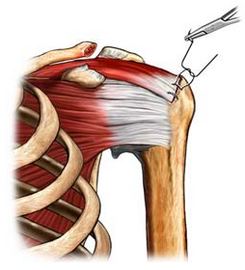Restoration of tendons
Description tendon repair
The operation is performed to restore a damaged or torn tendon.

Reasons for restoring tendons
Through the muscle tendon is attached to the bone. If the tendon is damaged or broken, Muscle can not function properly. Connection tendon helps to correct the problem.
Possible complications tendon repair
Complications are rare, but no procedure does not guarantee the absence of risk. If you plan to restore the tendon, you need to know about possible complications, which may include:
- Bleeding;
- Infection;
- Formation of scar tissue, which prevents normal movement of the tendon;
- Partial loss of function in the joints operated.
Some factors, that may increase the risk of complications:
- Age: 60 and older;
- Obesity;
- Smoking;
- Poor overall health;
- The use of some drugs.
We need to discuss these risks with your doctor before surgery.
How is the recovery of the tendon?
Preparation for the procedure
Before the surgery, your doctor may be imposed or carried out following:
- Medical checkup;
- Blood and urine tests;
- MRI scan – test, which uses magnetic waves, to make pictures of organs inside the body.
In the run-up procedure:
- Tell your doctor about taking any medications. A week before surgery, perhaps, you need to stop taking certain drugs:
- Aspirin or other anti-inflammatory drugs;
- Blood thinners, such as clopidogrel (Plaviks) or warfarin;
- We need to organize a trip for the operation and back home from the hospital;
- On the eve of the evening before surgery you can eat a light meal. Do not eat or drink anything the night.
Anesthesia
Depending on the cause of Hysteroscopy, may include the following types of anesthesia:
- General anesthesia – blocks any pain and the patient support in a sleep state during operation. Administered intravenously in the arm or hand.
- Regional anesthesia – blocks pain in a particular area of the body, the patient is awake. Administered by injection.
- Local anesthesia – anaesthetises body, during surgery, the patient is awake. It can be provided in the form of injections.
Procedure tendon repair
The doctor makes an incision in the skin around the damaged tendon. Broken ends of the tendon will be sewn together and attached to the bone. If you have a serious injury may be needed tendon graft. In this case, part of a healthy tendon is taken from other parts of the body. This tendon is used, to restore the gap. The doctor will examine the area of operation for damage nerves and blood vessels. At the end of the operation the incision is sewn up.
Immediately after the restoration of the tendon
Your doctor may splint or plaster. This will lock the injured area to restore the proper. Bus or gypsum, usually, left for several weeks.
How long will the recovery of the tendon?
Recovery time depends on the location and severity of the tendon injury. For Example, surgery for flexor tendon injuries in the finger may take 45-60 minutes.
Will it hurt when you restore the tendon?
You may experience pain and discomfort during recovery. The doctor will give pain medicine.
Care after tendon repair
After returning home, follow these steps:, to ensure the normal recovery:
- Keep the incision site clean and dry;
- Ask the doctor, when it is safe to shower, bath or expose the surgical site to water;
- Take your medicines, as prescribed by your doctor;
- If you feel better, You can return to daily activities and work;
- We need to see a doctor for removal of sutures;
- After removing the tires or plaster need to work with a physiotherapist, to reinforce the tendon;
- Be sure to follow your doctor's instructions.
The following are some tips on caring for the bus or plaster cast:
- If the operation area was put in plaster, not soak it with water;
- After removing the tires or gypsum, bath and shower can be taken as usual.
Contact your doctor after tendon repair
After returning home, you need to see a doctor, if there was any of the following symptoms of:
- Signs of infection, including fever and chills
- Redness, edema, strong pain, bleeding or discharge from the incision;
- Pain, which does not pass after taking pain medication appointed;
- Gypsum or bus gets wet, dirty;
- The skin under the cast becomes cold, colorless, numb or tingling is felt;
- Cough, breathlessness, chest pain, or severe nausea or vomiting;
- Other painful symptoms.
